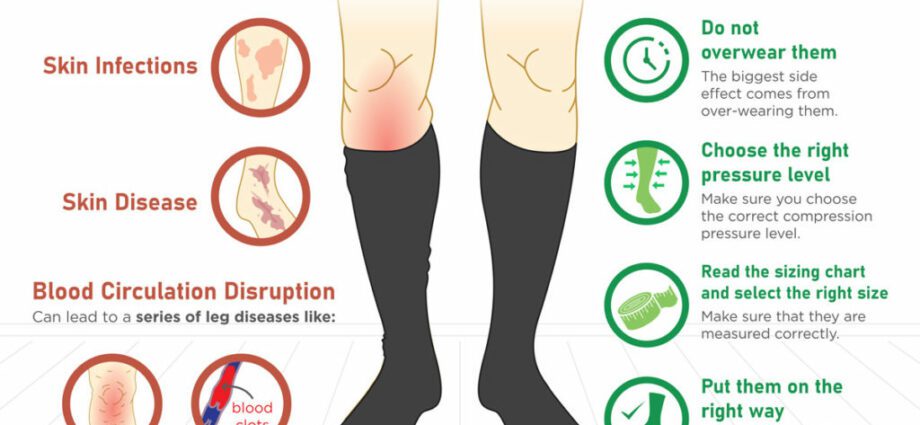Contents
- Compression and compression stockings: why should you wear them?
- Compression / compression stockings: what are they?
- Do not confuse “compression” and “contention”
- What are the effects of compression stockings?
- What are the uses of compression stockings?
- How to choose compression stockings?
- Precautions for using compression stockings
- Contraindications to wearing compression stockings
- Price and reimbursement of compression stockings
Compression and compression stockings: why should you wear them?
Compression / compression stockings: what are they?
Compression forms the basis of treatment for venous disease. It is of interest from the first symptoms.
Medical compression stockings are made of an elastic medical textile that exerts pressure on the legs, at rest or in activity, in order to allow better blood circulation: by limiting the dilation of the veins, the return of blood to the heart is improved. The pressure exerted is higher at the level of the ankle and then gradually decreases towards the top of the leg.
This pressure also helps reduce capillary leakage – blood outside the blood vessels – in the tissues and promotes lymphatic drainage – circulation of lymph in the lymphatic network – interstitial fluid – liquid present between the blood capillaries and cells.
By “compression stockings” is meant socks – stopping below the knee -, thigh highs – stopping at the root of the thigh – or tights. There is no demonstrated difference in effectiveness between the different types of socks. The pantyhose pantyhose has no compressive effectiveness. In the absence of a specific medical indication, the choice will be made on the type of stockings most comfortable to wear. It is generally advisable to remove them at night.
Do not confuse “compression” and “contention”
Warning: do not confuse “compression” and “contention”. Compression bands are inelastic – or little – and they put very little pressure on the skin and underlying tissues when at rest. On the other hand, during muscle contraction, they passively oppose the increase in the volume of the lower limb during each contraction linked to walking.
What are the effects of compression stockings?
Medical compression allows:
- To relieve and prevent venous symptoms: pain, swelling and heaviness in the legs;
- To prevent or reduce leg edema;
- To prevent or treat skin complications related to venous insufficiency;
- To help the healing of an ulcer;
- To prevent or treat phlebitis or venous thrombosis: blood clot in a vein.
What are the uses of compression stockings?
Wearing compression stockings is recommended in the following cases:
- Varicose veins (3 millimeters);
- After sclerotherapy – an endovenous ablative method intended to remove varicose veins and varicose vessels (the blood vessels supplying the varicose veins) on the lower limbs – or surgery for varicose veins;
- Chronic edema;
- Pigmentation – brownish darkening of the skin – or venous eczema;
- Lipodermatosclerosis: localized chronic inflammation and fibrosis of the skin and subcutaneous tissues of the lower leg;
- Venous hypodermitis;
- White atrophy: superficial ulcers located in the legs;
- A healed ulcer;
- An open ulcer.
Other uses may be recommended by the phlebologist.
In addition, all edema is not necessarily venous and the other primary causes – cardiac, renal, thyroid… – or the implication of the taking of a drug, must be eliminated.
How to choose compression stockings?
Compression stockings are medical devices and should not be self-medicated. They are prescribed to be adapted to the type of venous disease, its stage of development and the patient’s morphology.
Their indication will be made by the phlebologist after a clinical examination and a Doppler ultrasound.
The choice of the compressive force is very important. It is performed by the phlebologist on a case-by-case basis. Medical compression products are divided into four pressure classes, from weakest to strongest:
- Class 1 = 10-15 millimeters of mercury (mmHg);
- Class 2 = 15-20 mmHg;
- Class 3 = 20-36 mmHg;
- Class 4 = more than 36 mmHg.
Precautions for using compression stockings
An improperly worn compression stocking may be ineffective, but may also have negative effects on blood circulation and quality of life.
When prescribing them by the phlebologist or withdrawing them from the pharmacist, it is important to check:
- That the measurements of the legs were taken at different points: shoe size, ankle circumference, calf circumference, floor height-upper limit to define the correct size of the bottom;
- That the donning, fitting and wearing methods are explained by each of the stakeholders (phlebologist, nurse, pharmacist, etc.).
Contraindications to wearing compression stockings
The absolute contraindications for medical compression are:
- Obliterating arterial disease – obstructive damage to the arteries – of the lower limbs (PADI) with a systolic pressure index less than 0,6;
- Advanced diabetic microangiopathy (for compression greater than 30 mmHg);
- Phlegmatia cœrulea dolens – painful blue phlebitis with arterial compression;
- Septic thrombosis.
A regular reassessment of the benefit / risk ratio is necessary in the event of:
- PADI with a systolic pressure index between 0,6 and 0,9;
- Advanced peripheral neuropathy;
- Oozing or eczematized dermatosis;
- Intolerance to the fibers used.
Price and reimbursement of compression stockings
Compression stockings give rise to reimbursement by Health Insurance. Due to the regular use and washing constraints of compression stockings, Health Insurance can cover these products up to a maximum of eight pairs per year – from date to date – on medical prescription.
Many brands exist and prices vary between € 20 and € 80 depending on the class – the stronger the compression the higher the price -, of the type – tights, stockings or socks -, of the material …










